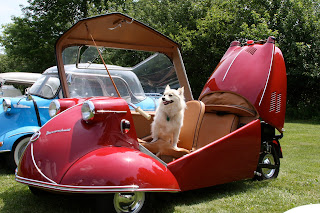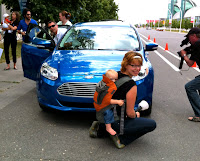Most of
these were vintage vehicles, highly prized collector’s items, and their owners have coddled them like pedigreed pups. A micro, as you know, is any vehicle with an engine
under 500 cc. They were wildly popular in the 1950s, when gas was scarce. Many
of the little cars had only three wheels, which in England and Germany, meant their
owners paid half the road tax. Ingenious,
mais non?
Here in
North America, we must wait for invitations to events like MicroNorth to enjoy
these diminutive darlings. Ralph Hough himself, a strapping six-foot former
policeman, has a collection of Messerschmitts, many of which were displayed on
the lawn. He got his extremely rare 1955 KR175 red Schmitt in Montreal, where
its original owner had brought it from England – the poor car was literally a
basket case! Only 10,000 of the KR175 were built between 1953 and 1955, so parts
were scarce. Of course Ralph sleuthed out the necessary parts, including the
factory original option “suitcase,” custom built to fit in the tiny luggage
space.
 We loved
the pale yellow 1957 Isetta, so much like dear cousin Rosalia’s, who keeps
company with the town doctor in the southern Italian town of Campobasso. Oh, the hot summers we enjoyed, travelling along the Biferno river in
the mountains. This Isetta even
had a wicker basket on the back like Rosalia’s, perfect for picnics. What that
clever girl, or cucciune as the
doctor would say, could do with a little prosciutto
and provolone! Like all Isettas, this one had a one cylinder 300 cc Hemi
engine – yes, that’s right, a Hemi. Raise your hand if you know that any engine
with a hemispherical cylinder head is called a Hemi. The Isetta story is one of
my favourites – they were originally manufactured by an Italian company called
Iso, which made refrigerators. Isetta simply means “little Iso.” Sitting in the
little car, my nose thrilled to the scent of vintage leather and two-stroke –
and I could almost smell the prosciutto…
We loved
the pale yellow 1957 Isetta, so much like dear cousin Rosalia’s, who keeps
company with the town doctor in the southern Italian town of Campobasso. Oh, the hot summers we enjoyed, travelling along the Biferno river in
the mountains. This Isetta even
had a wicker basket on the back like Rosalia’s, perfect for picnics. What that
clever girl, or cucciune as the
doctor would say, could do with a little prosciutto
and provolone! Like all Isettas, this one had a one cylinder 300 cc Hemi
engine – yes, that’s right, a Hemi. Raise your hand if you know that any engine
with a hemispherical cylinder head is called a Hemi. The Isetta story is one of
my favourites – they were originally manufactured by an Italian company called
Iso, which made refrigerators. Isetta simply means “little Iso.” Sitting in the
little car, my nose thrilled to the scent of vintage leather and two-stroke –
and I could almost smell the prosciutto… And then,
complete shock. A real, live beige 1981 Syrena from Poland. Owner Slawek had
brought it over five years ago. With its 850 cc engine, it perhaps exceeded the
microcar standards, but I didn’t care. I have not seen a Syrena since the days
in Krakow, visiting with cousin Agnieszka. We would smuggle contraband onto the
black market and then feast on forbidden delicacies like Baltic caviar? Smacznego! Who would suspect two pretty tail-wagging blondes?
And then,
complete shock. A real, live beige 1981 Syrena from Poland. Owner Slawek had
brought it over five years ago. With its 850 cc engine, it perhaps exceeded the
microcar standards, but I didn’t care. I have not seen a Syrena since the days
in Krakow, visiting with cousin Agnieszka. We would smuggle contraband onto the
black market and then feast on forbidden delicacies like Baltic caviar? Smacznego! Who would suspect two pretty tail-wagging blondes? 









